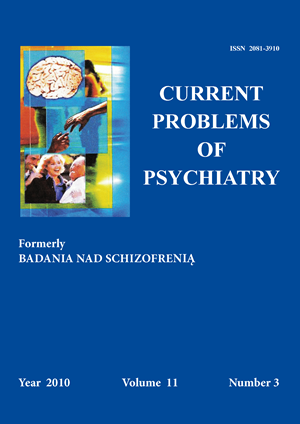Children’s fear of the doctor- results of action „Teddy Bear Hospital”
Keywords:
children, medical students, fear of doctors, Wong’s scaleAbstract
The article presents an analysis of effectiveness of project called „ Teddy Bear Hospital” organized by European Medical Students’ Association in Warsaw. One of the points of this project are visits of children from kinder-gartens with their toys in “hospital”. The roles of parents are played by children, teddy bears or dolls are the patients and the students of Medical Faculty of Medical University of Warsaw work as doctors.
The main aim of this project was to minimize the fear of doctors among children from kindergartens and make them acquainted with the work of medical staff.
Studying the level of fear, the attitudes towards the doctors, dentists and medical procedures conducted during this action, allowed for estimation of the level of knowledge of these children about treatment process and hospitalization.
The research methods used were: role playing as in “hospital”, use of Wong’s scale and a number of conversations (not only with children but also with their carers) and comprehensive observations. The studied groups consisted of 215 individuals in the study group and 178 in the control group, aged 3-6 years. The analysis of collected material leads to the following conclusions: 1. children generally are not afraid of doctors or the examination but the doctor is not perceived as being extremely friendly to them; 2. this action showed a high effectiveness: in the study group the levels of anxiety and aggression, and fears about the examination decreased significantly
References
1. Kępiński A. Lęk. Warszawa; Sagittarius: 1995.
2. Klichowski L. Lęk, strach, panika : przyczyny i zapobieganie. Poznań; Printer: 1994.
3. Klichowski L. Wszystko o lęku : przyczyny i zapobieganie. Kielce; Jedność: 2002.
4. Maslow A. H. W stronę psychologii istnienia. Poznań; REBIS: 2004.
5. Sitarczyk M. Lęk tworzy czy niszczy? Język Polski w Szkole-Gimnazjum. 1999; 2: 98-101.
6. Smith K., Cowie H. Blades H. Understanding Children`s Development. Oxford; Blackwell: 1999.
7. Turner J.S., Helms D.B. Rozwój człowieka. Warszawa; WSIP: 1999.
8. Bemis J., Barrada A. Oswoić lęk. Gdańsk; Gdańskie Wydawnictwo Psychologiczne: 2001.
9. Jarosz M. Psychologia lekarska. Warszawa; PZWL: 1978.
10. Dobrzańska B. Przyczyny przeżywania strachu. Życie Szkoły, 1997; 4: 250-251.
11. Pochwic T. Lęk u dziecka. Warszawa; PZWL: 1985.
12. Burtowy M. Lęk w opinii dzieci w wieku wczesnoszkolnym. Nauczyciel i Szkoła, 2000; 1: 83-87.
13. Shaw M.A. Dziecięce leki: o wychowaniu dziecka w świecie, który napawa je lekiem. Poznań; Moderski i S-ka: 1999.
14. Soroka A. Sytuacje lękowe w życiu dzieci sześcioletnich. Nauczyciel i Szkoła, 2000; 1: 88-94.
15. Zaborowski Z. Wstęp do metodologii badań pedagogicznych. Wrocław; Ossolineum: 1973.
16. Arndt M. red. Didaktische Spiele für Kindergarten-Spiel- und Lernnachmittage. Ganztägige Bildung und Erziehung in der Unterstufe - Familie. Berlin; Volk und Wissen: 1969.
17. Okoń W. Zabawa a rzeczywistość. Warszawa; WSIP: 1987.
18. Brzezińska A. Społeczna psychologia rozwoju (t.3). Warszawa; SCHOLAR: 2004.
19. Matczak A. Style poznawcze. Rola indywidualnych preferencji. Warszawa; PWN: 1982.
20. Piszczek M. Terapia zabawą. Terapia przez sztukę. Jarogniewie; SPiSDPS: 1998.
21. Tyszkowa M. Zabawa dziecka: symbolizacja, poznanie, autokomunikacja. Kwartalnik Pedagogiczny, 1988; 3-4.
22. Keyserlingk L. Opowieści przeciwko lękom. Kielce; Jedność: 2000.
23. Molicka M. Uwarunkowania lęku u dzieci. Grupa i Zabawa, 1999; 2: 6-12.
24. Molicka M. Bajkoterapia: o lękach dzieci i nowej metodzie terapii. Poznań; Media Rodzina: 2002.
25. Meyer-Glitza E. Jakub pogromca strachu: terapeutyczne opowiadania dla dzieci przeżywających lęki. Kielce; Jedność: 2001.
26. Harwas-Napierała B., Trempała J. Psychologia rozwoju człowieka (t.2). Warszawa; PWN: 2000.
27. Seul S. Zmaganie się dziecka ze stresem. Edukacja i Dialog, 1999; 4: 20-26.


